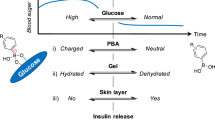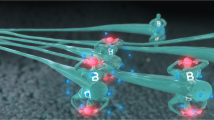Abstract
Insulin therapy has proven its effectiveness in the treatment of diabetes, but there are still several limitations, including insulin pump failure, infusion set blockage, infusion site problems, insulin stability issues, and user error, among others. In this study, we examine the fabrication of a layered hydrogel system that combines a microfluidic device with both sensing and drug delivery mechanisms. This allows for the continuous monitoring of the glucose concentration and delivers a concentration of drug that is proportional to the concentration of analyte detected in a solution. We developed a 3D-printed glucose sensitive hydrogel system where microfluidic channels would swell and de-swell in the presence of glucose. Here, we report early stage findings on hydrogel-based microfluidics and the resulting drug release kinetics of the hydrogel system.
Graphical abstract





Similar content being viewed by others
References
N. Sarwar et al., Diabetes mellitus, fasting blood glucose concentration, and risk of vascular disease: a collaborative meta-analysis of 102 prospective studies. Lancet 375(9733), 2215–2222 (2010). https://doi.org/10.1016/S0140-6736(10)60484-9
R. Saran et al., US renal data system 2014 annual data report: epidemiology of kidney disease in the United States. Am J Kidney Dis 66(1 Suppl 1), A7 (2015). https://doi.org/10.1053/J.AJKD.2015.05.001
Diabetes Statistics. https://www.diabetesresearch.org/diabetes-statistics. (Accessed 06, Jun, 2022).
W.T. Cefalu et al., Insulin access and affordability working group: conclusions and recommendations. Diabetes Care 41(6), 1299–1311 (2018). https://doi.org/10.2337/DCI18-0019
I.L. Valuev, L.V. Vanchugova, L.I. Valuev, Polymeric hydrogels for controlled insulin release”. Appl. Biochem. Microbiol. 56(5), 505–511 (2020). https://doi.org/10.1134/S0003683820050154
S. Mansoor, P.P.D. Kondiah, Y.E. Choonara, Advanced hydrogels for the controlled delivery of insulin. Pharmaceutics 13(12), 2113 (2021). https://doi.org/10.3390/PHARMACEUTICS13122113
K.S. Vasu, S. Sridevi, S. Sampath, A.K. Sood, Non-enzymatic electronic detection of glucose using aminophenylboronic acid functionalized reduced graphene oxide. Sens. Actuators B Chem. 221, 1209–1214 (2015). https://doi.org/10.1016/J.SNB.2015.07.101
Swelling properties of phenylboronic acid containing hydrogels. https://conservancy.umn.edu/handle/11299/121133. Accessed 10 May 2022
X. Yang, B.L. Dargaville, D.W. Hutmacher, Elucidating the molecular mechanisms for the interaction of water with polyethylene glycol-based hydrogels: influence of ionic strength and gel network structure. Polymers (Basel) 13(6), 845 (2021). https://doi.org/10.3390/POLYM13060845
G. Sennakesavan, M. Mostakhdemin, L.K. Dkhar, A. Seyfoddin, S.J. Fatihhi, Acrylic acid/acrylamide based hydrogels and its properties: a review. Polym. Degrad. Stab. 180, 109308 (2020). https://doi.org/10.1016/J.POLYMDEGRADSTAB.2020.109308
G. Lin et al., Osmotic swelling pressure response of smart hydrogels suitable for chronically-implantable glucose sensors. Sens. Actuators B Chem. 144(1), 332 (2010). https://doi.org/10.1016/J.SNB.2009.07.054
J.H. Chen, T. Michiue, O. Inamori-Kawamoto, S. Ikeda, T. Ishikawa, H. Maeda, Comprehensive investigation of postmortem glucose levels in blood and body fluids with regard to the cause of death in forensic autopsy cases. Leg. Med. 17(6), 475–482 (2015). https://doi.org/10.1016/J.LEGALMED.2015.08.004
R. Silbert, A. Salcido-Montenegro, R. Rodriguez-Gutierrez, A. Katabi, R.G. McCoy, Hypoglycemia among patients with type 2 diabetes: epidemiology, risk factors, and prevention strategies. Curr. Diabetes Rep. (2018). https://doi.org/10.1007/S11892-018-1018-0
Author information
Authors and Affiliations
Corresponding author
Ethics declarations
Conflict of interest
The authors declare that they have no conflicts of interest with the work reported in this paper.
Data availability
The datasets generated during and/or analyzed during the current study are available from the corresponding author on reasonable request.
Rights and permissions
Springer Nature or its licensor holds exclusive rights to this article under a publishing agreement with the author(s) or other rightsholder(s); author self-archiving of the accepted manuscript version of this article is solely governed by the terms of such publishing agreement and applicable law.
About this article
Cite this article
Velraj, A., Bates, J. Integrated hydrogel sensor-actuator for glucose sensitivity and drug elution. MRS Advances 7, 663–667 (2022). https://doi.org/10.1557/s43580-022-00331-1
Received:
Accepted:
Published:
Issue Date:
DOI: https://doi.org/10.1557/s43580-022-00331-1




